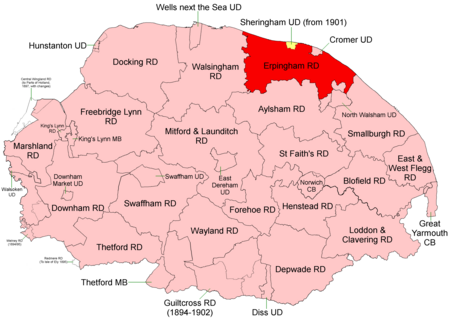Erpingham Rural District

Erpingham Rural District was a rural district in Norfolk, England from 1894 to 1974.It was formed under the Local Government Act 1894 based on the Erpingham rural sanitary district, taking its name from the ancient North and South Erpingham hundreds - but did not, initially, include some parishes from these hundreds including Erpingham parish itself. It lay on the north coast of Norfolk around the Urban Districts of Cromer and, later, Sheringham (created 1901, extended 1914). In 1935 Erpingham RD took in several parishes from Aylsham Rural District, and ceded smaller areas to Walsingham and Smallburgh RDs. In 1974, the district was abolished under the Local Government Act 1972, and became part of the North Norfolk district.
Excerpt from the Wikipedia article Erpingham Rural District (License: CC BY-SA 3.0, Authors, Images).Erpingham Rural District
North Norfolk
Geographical coordinates (GPS) Address Website Nearby Places Show on map
Geographical coordinates (GPS)
| Latitude | Longitude |
|---|---|
| N 52.86 ° | E 1.19 ° |
Address
Ferndale Farm
NR11 7AG North Norfolk
England, United Kingdom
Open on Google Maps










